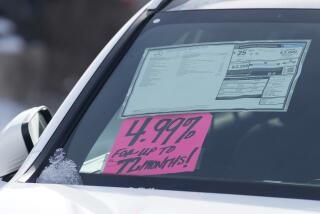Finding Best Route to New Car
Car dealers are offering a cacophony of buyer incentives--ranging from cut-rate financing to cash-back offers--in an effort to lure buyers into auto showrooms.
The deals can cut the cost of a new car by thousands of dollars. But should you bite?
That depends on several factors, including how soon you’ll need a car, your credit record, how much you can afford to pay each month and whether you want your savings now or later.
But one thing’s for sure: Deals of this magnitude don’t come around very often. Although some special deals--either cash rebates or low-rate financing--are common at this time of year, never before have so many auto makers offered so many incentives on so many cars, industry experts say.
“Buyer incentives have been high and rising all through this year,” said Bob Schnorbus, chief economist with J.D. Power & Associates, an auto research firm in Detroit. “But what we are seeing right now is unprecedented. Incentives are at record high levels.”
General Motors Corp. and Ford Motor Co. are offering buyers a choice between 0% financing and factory rebates on every 2001 model. The deals, which last through October, are not quite as generous on sport-utility vehicles, trucks or 2002 models. With these vehicles, the cash-back offers are smaller and 0% financing applies to only relatively short-term loans--three years or less. Buyers wanting longer-term loans would pay 0.9% to 4.9%--rates substantially closer to the going market rate of 6.5% to 7.5% for new-car loans.
Meanwhile, DaimlerChrysler is offering low-rate financing on most 2002 models. Nissan Motor Co., Toyota Motor Corp. and Honda Motor Co. dealers are advertising 2.9% to 4.9% financing on selected vehicles--a more common marketing gambit aimed at selling slower-moving models.
However, all the deals have catches and caveats consumers ought to know before they shop. Specifically:
* Not everyone can qualify for the low-rate financing. You generally must have near-perfect credit to get the best rates, says Gail Hillebrand, executive director of Consumers Union in San Francisco.
* You’ll need to be prepared to do some math: Those who qualify for incentives will have to choose between low-rate financing or factory cash-back offers. It’s an either-or proposition, acknowledges Jeff Roegner, a spokesman at GM in Detroit.
* Monthly payments on low-rate loans might be more than you can afford because some of the financing deals are short-term--24 to 36 months.
That said, for anyone in the market for a new car, the spectrum of low-rate or reduced-price deals makes this an unusually good time to buy.
“It was already a time of very strong affordability, but this has enhanced it significantly,” said Paul Taylor, chief economist with the National Automobile Dealers Assn. in McLean, Va.
How should buyers choose between cash-back and low-rate financing?
First and foremost, consider whether you’ll qualify for the loans. Although some car makers extend these offers to virtually anyone with good credit, others restrict the offers to those with “tier one” credit. That generally means only people who qualify would be those who have so-called FICO credit scores exceeding 700.
(FICO is a computerized credit score, which ranges from a high of 900 to a low of 300. Scores above 700 are considered excellent; those under 600 are poor. Several companies will sell you a copy of your credit score and tips on how to improve it. However, you can get a free guesstimate of your score at E-Loan.com.)
Meanwhile, those who don’t have much cash for a down payment may prefer the cash-back offers, because the factory rebates can be used to help defray the upfront cost of the car.
If you qualify for both incentives, some calculating is necessary to figure out which deal is best.
Generally speaking, the financing offer is the best deal for those buying expensive cars and hoping to finance them over long periods.
To some degree, however, that depends on the car you’re buying. That’s because the cash-back offers vary widely by make and model year. For example, a 2001 Ford Windstar minivan carries a $3,000 factory rebate, but the rebate on a 2002 Ford Mustang is just $500. Sticker prices on both models run about $25,000, depending on which options are included.
So in some cases, the cash-back offer may be worth more than the low-rate financing. But the only way to know for sure is to calculate the value of the financing offer and compare it with the cash rebate to see which provides the greater savings.
What’s the low-rate financing worth? That depends on the amount that’s financed, the duration of the loan, the interest rate and what it might cost to finance the same car elsewhere.
However, over the life of a loan, 0% financing saves a buyer roughly $103 for every $1,000 financed on a three-year loan; $138 for every $1,000 financed on a four-year loan; and $174 for every $1,000 financed on a five-year loan. These savings are calculated against a 6.5% new-car loan--about the lowest rate available on outside financing.
That would make a five-year, 0% loan on a $20,000 purchase worth $3,480 (20 multiplied by $174) compared with conventional financing.
How does the math work out on the long-term, low-interest loans for SUVs or 2002 models?
The benefit of 2.9% financing versus 6.5% financing would work out to roughly $58 per $1,000 financed on a three-year deal; $78 per $1,000 financed over four years; and $98.50 per $1,000 financed over five years.
Consider a buyer who is shopping for a Chevrolet Suburban with a $35,000 sticker price. On 2001 Suburbans, GM is offering a choice between a $1,500 cash rebate or low-rate financing. In this case, a buyer with a good credit score could get 0% financing for up to three years; 0.9% financing over four years; or 2.9% financing for up to five years.
The numbers work out like this:
If the buyer opted for 0% financing with no down payment, the monthly payment would be $972.22 for 36 months, for a total of $35,000.
If the buyer took the rebate, it would reduce the purchase price to $33,500. Financed at 6.5%, the monthly payment would be $1,027, making the total cost of the car $36,963.
If the buyer opted for the 2.9% financing for 60 months instead of the rebate and made no down payment, the monthly payment on the $35,000 loan would be $627.35. However, over five years, the payments would add to $37,641.
Clearly, if you can afford the monthly payments, the 0% financing provides the best value in the case above. But buyers who need low monthly payments might accept a slightly higher financing rate to stretch their payments over longer periods.
“You can’t go lower than 0%,” said Taylor of the auto dealers group. “It takes all the financing cost out of the cost of buying a car.”
(BEGIN TEXT OF INFOBOX / INFOGRAPHIC)
DO THE MATH
Here’s how to figure the savings on $1,000 financed at 0%, 0.9% and 2.9% vs. the same amount financed at 6.5%.
1. Round the amount to be financed to the nearest thousand and divide by 1,000
2. Find the figure in the chart that corresponds with to the financing rate and the duration of the loan.
3. Multiply the results from the first step by the figure from the second step. For example, someone financing $20,000 over five years, or 60 months, at 0.9% would multiply 20 by $150.92. The savings would amount to $3,018.
*--*
Duration Savings vs. a 6.5% loan per $1,000 financed at of loan 0% 0.9% 2.9% 36 months $103.36 $89.46 $57.96 48 months $138.33 $119.83 $78.24 60 months $173.95 $150.92 $98.51
*--*
Source: Times research
More to Read
Inside the business of entertainment
The Wide Shot brings you news, analysis and insights on everything from streaming wars to production — and what it all means for the future.
You may occasionally receive promotional content from the Los Angeles Times.










